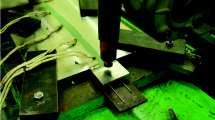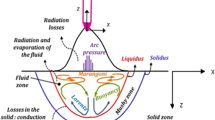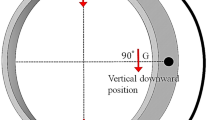Abstract
A three-dimensional CFD-model was developed to investigate Active-TIG welding of 304L-SS, involving heat transfer, fluid flow, solidification, plasma arc effect, Marangoni convections, magnetohydrodynamics and oxide particle trajectory. The aim was to understand how flux-induced particles are distributed in the weld line. The results, validated with available experimental data, showed that A-TIG forms a pool with an increased maximum temperature (2800 K) and depth-to-width ratio (0.7). The flow pattern, dominated by two vortices due to Marangoni convection, collects particles from the surface, submerges them into the pool and leads to entrapment of the most in the weld cross section. The motion path of 70% of particles ended at the deeper half of the cross section. Detailed numerical picture of A-TIG weld pool was presented and discussed in this study to be a step in understanding of the nature of Active-TIG welding and to assist in improving the process.
















Similar content being viewed by others
Abbreviations
- a :
-
acceleration (m/s2)
- B :
-
magnetic field (T)
- c :
-
specific heat (J/kgK)
- D :
-
particle diameter (m)
- F :
-
force (N)
- f :
-
mass fraction
- H :
-
heat transfer coefficient (W/m2 K)
- h :
-
enthalpy (J/kg)
- I :
-
welding current (A)
- J :
-
current density (A/m2)
- k :
-
thermal conductivity (W/mK)
- K :
-
permeability (m2)
- K o :
-
porosity constant (m2)
- L f :
-
latent heat of fusion (J/kg)
- L 1 :
-
length of sheet (m)
- L 2 :
-
thickness of sheet (m)
- L 3 :
-
width of sheet (m)
- m :
-
mass (kg)
- Ma:
-
Marangoni number
- P :
-
pressure (Pa)
- q :
-
heat flux (W/m2)
- r :
-
radial position (m)
- r o :
-
effective arc radius (m)
- R :
-
residual of the solution
- Rm:
-
magnetic Reynold number
- S :
-
enthalpy source term (W/m3)
- T :
-
temperature (K)
- T o :
-
environment temperature (K)
- t :
-
time (s)
- u :
-
velocity in x direction (m/s)
- v :
-
velocity in y direction (m/s)
- V :
-
welding voltage (V)
- w :
-
velocity in z axis direction (m/s)
- x :
-
x position (m)
- y :
-
y position(m)
- z :
-
z position(m)
- γ :
-
surface tension (J/m2)
- τ M :
-
Marangoni surface tension (Pa)
- β :
-
arc distribution factor
- η :
-
arc efficiency
- μ :
-
dynamic viscosity (kg/ms)
- μ m :
-
magnetic permeability (wb/Am)
- ρ :
-
density (kg/m3)
- D:
-
Darcy
- EMF:
-
electromotive force
- M:
-
Marangoni force
- cooling:
-
cooling wall
- D:
-
drag
- G:
-
gravity
- heating:
-
heating wall
- L:
-
Liquidus
- p:
-
particle
- S:
-
Solidus
- W:
-
welding
References
Messler RW (1999) Fusion welding processes. Principles of welding. In: Wiley Online Books, pp 40–93
Modenesi PJ, Apolin R, Pereira IM (2000) TIG welding with single-component fluxes. J Mater Process Technol 99:260–265
Heiple CR, Roper JR (1982) Mechanism for minor element effect on GTA fusion zone geometry. Weld J 61:975–1025
Zhao YZ, Zhao HY, Lei YP, Shi YW (2007) Theoretical study of Marangoni convection and weld penetration under influence of high oxygen content in base metal. Sci Technol Weld Join 12:410–417
Zhao CX, Kwakernaak C, Pan Y, Richardson IM, Saldi Z, Kenjeres S, Kleijn CR (2010) The effect of oxygen on transitional Marangoni flow in laser spot welding. Acta Mater 58:6345–6357
Li D, Lu S, Dong W, Li D, Li Y (2012) Study of the law between the weld pool shape variations with the welding parameters under two TIG processes. J Mater Process Technol 212:128–136
Li C, Shi Y, Gu Y, Fan D, Zhu M (2018) Effects of different activating fluxes on the surface tension of molten metal in gas tungsten arc welding. J Manuf Process 32:395–402
Wang X, Huang J, Huang Y, Fan D, Guo Y (2017) Investigation of heat transfer and fluid flow in activating TIG welding by numerical modeling. Appl Therm Eng 113:27–35
Berthier A, Paillard P, Carin M, Valensi F, Pellerin S (2012) TIG and A-TIG welding experimental investigations and comparison to simulation, Part 1: identification of Marangoni effect. Sci Technol Weld Join 17:609–615
Vidyarthy RS, Dwivedi DK (2016) Activating flux tungsten inert gas welding for enhanced weld penetration. J Manuf Process 22:211–228
Aucott L, Dong H, Mirihanage W, Atwood R, Kidess A, Gao S, Wen S, Marsden J, Feng S, Tong M, Connolley T, Drakopoulos M, Kleijn CR, Richardson IM, Browne DJ, Mathiesen RH, Atkinson HV (2018) Revealing internal flow behaviour in arc welding and additive manufacturing of metals. Nat Commun 9:5414
Feyzi F (2012) Study of effective factors on distribution of the oxide particles in A-TIG weld pool of 304L stainless steel. Sahand University of Technology, Sahand
Jaidi J, Dutta P (2004) Three-dimensional turbulent weld pool convection in gas metal arc welding process. Sci Technol Weld Join 9:407–414
Yushchenko KA, Kovalenko DV, Krivtsun IV, Demchenko VF, Kovalenko IV, Lesnoy AB (2009) Experimental studies and mathematical modelling of penetration in TIG and A-TIG stationary arc welding of stainless steel. Weld World 53:R253–RR63
Crowe C, Michaelides E, Schwarzkopf JD (2016) Multiphase flow handbook, 2nd edn. Mechanical and aerospace engineering series. CRC Press, Boca Raton
Miki Y, Thomas BG (1999) Modeling of inclusion removal in a tundish. Metall Mater Trans B 30:639–654
Horwitz J, Mani A (2016) Accurate calculation of Stokes drag for point-particle tracking in two-way coupled flows. J Comput Phys 318:85–109
Mahanthesh B, Gireesha BJ (2018) Thermal Marangoni convection in two-phase flow of dusty Casson fluid. Results Phys 8:537–544
Murphy AB (2015) A perspective on arc welding research: the importance of the arc, unresolved questions and future directions. Plasma Chem Plasma Process 35:471–489
Hong C-P (2004) Computer modelling of heat and fluid flow in materials processing. IOP Publishing Ltd., Bristol
Iida T, Guthrie RIL. The physical properties of liquid metals: Oxford : Clarendon press; 1988.
Pop I, Postelnicu A, Groşan T (2001) Thermosolutal Marangoni forced convection boundary layers. Meccanica 36:555–571
Jafari A (2011) Modeling of solidification structure evolution and macrosegregation in direct-chill casting of aluminum alloys. Iran University Of Science and Technology, Tehran
Kumar A, Debroy T (2003) Calculation of three-dimensional electromagnetic force field during arc welding.
Chen K (2007) Micro Particle Transport and deposition in human upper airways. Publisher, Seattle
Patankar SV (1980) Numerical heat transfer and fluid flow. Hemisphere Publishing Corporation, New York
Jafari A, Seyedein SH, Aboutalebi MR (2011) Semi-implicit method for thermodynamically linked equations in phase vhange problems (SIMTLE). Appl Math Model 35:4774–4789
Turquais B (2017) Influence of the steel properties on the progression of a severe accident in a nuclear reactor. CEA Cadarache, Saint Paul Lez Durance
Tseng K-H, Hsu C-Y (2011) Performance of activated TIG process in austenitic stainless steel welds. J Mater Process Technol 211:503–512
Tseng K-H (2013) Development and application of oxide-based flux powder for tungsten inert gas welding of austenitic stainless steels. Powder Technol 233:72–79
Wu B, Wang B, Zhao X, Peng H (2018) Effect of active fluxes on thermophysical properties of 309 L stainless-steel welds. J Mater Process Technol 255:212–218
Gao J, Wu C (2001) Experimental determination of weld pool geometry in gas tungsten arc welding. Sci Technol Weld Join 6:288–292
Stadler M, Masquere M, Freton P, Gonzalez JJ (2017) Experimental characterisation of the weld pool expansion in a tungsten inert gas configuration. Sci Technol Weld Join 22:319–326
Sen D, Ball KS, Pierson MA (2011) Numerical investigation of transient Marangoni effects on weld pool dynamics in gas tungsten arc welding of stainless steel. IMECE2011: Publisher.
Acknowledgements
The authors would like to acknowledge the Department of Materials and Metallurgical Engineering at Amirkabir University of Technology. This research did not receive any specific grant from funding agencies in the public, commercial or not-for-profit sectors.
Author information
Authors and Affiliations
Corresponding author
Additional information
Publisher’s note
Springer Nature remains neutral with regard to jurisdictional claims in published maps and institutional affiliations.
Recommended for publication by Study Group 212 - The Physics of Welding
Rights and permissions
About this article
Cite this article
Pourmand, S., Jafari, A.R. & Ebrahimi, A. Numerical investigation of heat, flow and particle trajectory in A-TIG welding pool of 304L-SS. Weld World 64, 2145–2157 (2020). https://doi.org/10.1007/s40194-020-00990-4
Received:
Accepted:
Published:
Issue Date:
DOI: https://doi.org/10.1007/s40194-020-00990-4




